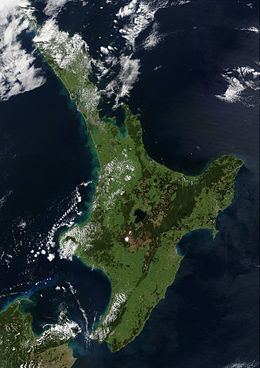Location Oceania Highest elevation 2,797 m (9,177 ft) ISO 3166-2:NZ NZ-N Area 113,729 km² | Area rank 14th Regions 9 Elevation 2,797 m Archipelago New Zealand | |
 | ||
Points of interest Bay of Islands, Tongariro National Park, Tongariro Alpine Crossing, Waiotapu, Sky Tower Destinations | ||
New zealand north island
The North Island or Te Ika-a-Māui (Māori) is one of the two main islands of New Zealand, separated from the slightly larger but much less populous South Island by Cook Strait. The island's area is 113,729 square kilometres (43,911 sq mi), making it the world's 14th-largest island. It has a population of 3,596,200 (June 2016).
Contents
- New zealand north island
- Map of North Island New Zealand
- New zealand travel advice north island or south island
- Naming and usage
- Mori mythology
- Economy
- Ecology
- Regions
- Cities and towns
- Healthcare
- Bays and coastal features
- Lakes and rivers
- Capes and peninsulas
- Forests and national parks
- Volcanology
- Other
- References
Map of North Island, New Zealand
Twelve main urban areas (half of them officially cities) are in the North Island. From north to south, they are Whangarei, Auckland, Hamilton, Tauranga, Rotorua, Gisborne, New Plymouth, Napier, Hastings, Whanganui, Palmerston North, and Wellington, the capital, located at the south-west extremity of the island. About 77% of New Zealand's population lives in the North Island.
New zealand travel advice north island or south island
Naming and usage
Although the island has been known as the North Island for many years, in 2009 the New Zealand Geographic Board found that, along with the South Island, the North Island had no official name. After a public consultation, the board officially named the island North Island or Te Ika-a-Maui in October 2013.
In prose, the two main islands of New Zealand are called the North Island and the South Island, with the definite articles. It is normal to use the preposition in rather than on, for example "Hamilton is in the North Island", "my mother lives in the North Island". Maps, headings, tables and adjectival expressions use North Island without the.
Māori mythology
According to Māori mythology, the North and South Islands of New Zealand arose through the actions of the demigod Māui. Māui and his brothers were fishing from their canoe (the South Island) when he caught a great fish and pulled it from the sea. While he was not looking his brothers fought over the fish and chopped it up. This great fish became the North Island and thus a Māori name for the North Island is Te Ika-a-Māui (The Fish of Māui). The mountains and valleys are believed to have been formed as a result of Māui's brothers' hacking at the fish. Until the early 20th Century, an alternative Māori name for the North Island was Aotearoa. In present usage, Aotearoa is a collective name for New Zealand as a whole.
Economy
The sub-national GDP of the North Island was estimated at US$102.863 billion in 2003, 79% of New Zealand's national GDP.
Ecology
The North Island is divided into two ecoregions within the Temperate broadleaf and mixed forests Biome, the northern part being the Northland temperate kauri forest, and the southern part being the North Island temperate forests. The island has an extensive flora and bird population, with numerous National Parks and other protected areas.
Regions
Nine local government regions cover the North Island and all its adjacent islands and territorial waters.
Cities and towns
The North Island has a larger population than the South Island with both the country's largest city, Auckland as well as the capital, Wellington at either ends of the island.
Healthcare
Healthcare in the North Island is provided by fifteen District Health Boards (DHBs). Organised around geographical areas of varying population sizes, they are not coterminous with the Local Government Regions.
